ATR-mediated CD47 and PD-L1 up-regulation restricts radiotherapy-induced immune priming and abscopal responses in colorectal cancer
- PMID: 35687697
- PMCID: PMC9373855
- DOI: 10.1126/sciimmunol.abl9330
ATR-mediated CD47 and PD-L1 up-regulation restricts radiotherapy-induced immune priming and abscopal responses in colorectal cancer
Abstract
Radiotherapy (RT) of colorectal cancer (CRC) can prime adaptive immunity against tumor-associated antigen (TAA)-expressing CRC cells systemically. However, abscopal tumor remissions are extremely rare, and the postirradiation immune escape mechanisms in CRC remain elusive. Here, we found that irradiated CRC cells used ATR-mediated DNA repair signaling pathway to up-regulate both CD47 and PD-L1, which through engagement of SIRPα and PD-1, respectively, prevented phagocytosis by antigen-presenting cells and thereby limited TAA cross-presentation and innate immune activation. This postirradiation CD47 and PD-L1 up-regulation was observed across various human solid tumor cells. Concordantly, rectal cancer patients with poor responses to neoadjuvant RT exhibited significantly elevated postirradiation CD47 levels. The combination of RT, anti-SIRPα, and anti-PD-1 reversed adaptive immune resistance and drove efficient TAA cross-presentation, resulting in robust TAA-specific CD8 T cell priming, functional activation of T effectors, and increased T cell clonality and clonal diversity. We observed significantly higher complete response rates to RT/anti-SIRPα/anti-PD-1 in both irradiated and abscopal tumors and prolonged survival in three distinct murine CRC models, including a cecal orthotopic model. The efficacy of triple combination therapy was STING dependent as knockout animals lost most benefit of adding anti-SIRPα and anti-PD-1 to RT. Despite activation across the myeloid stroma, the enhanced dendritic cell function accounts for most improvements in CD8 T cell priming. These data suggest ATR-mediated CD47 and PD-L1 up-regulation as a key mechanism restraining radiation-induced immune priming. RT combined with SIRPα and PD-1 blockade promotes robust antitumor immune priming, leading to systemic tumor regressions.
Conflict of interest statement
Conflict of interest:
M.A.C. reports grants and personal fees from ImmunoGenesis, Inc., personal fees from Alligator Bioscience, Inc., personal fees from ImmunOS, Inc., grants and personal fees from ImmunoMet, Inc., personal fees from Oncoresponse, Inc., personal fees from Pieris, Inc., personal fees from Nurix, Inc., personal fees from Aptevo, Inc., personal fees from Servier, Inc., personal fees from Kineta, Inc., personal fees from Salarius, Inc., personal fees from Xencor, Inc., personal fees from Agenus, Inc., personal fees from Mereo, Inc., personal fees from Amunix, Inc., personal fees from Adagene, Inc., outside the submitted work; in addition, M.A.C. has a patent (US 9,868,961 B2) Methods and Composition for Localized Secretion of Anti-CTLA-4 Antibodies with royalties paid to multiple licensees, a patent (PCT/US2019/022295) Dual specificity antibodies which bind both PD-L1 and PD-L2 and prevent their binding to PD-1 with royalties paid to ImmunoGenesis, Inc., and a patent (#17/065,304) Cyclic Dinucleotides as Agonists of Stimulator of Interferon Gene Dependent Signaling licensed to ImmunoGenesis, Inc.. C.M.T. is an inventor on the patent (#16/766,025) held by MD Anderson Cancer Center that covers radioprotection of the gastrointestinal tract with oral amifostine. C.M.T. is on the medical advisory board of Accuray and is a paid consultant for Xerient Pharma and Phebra Pty, Ltd. The remaining authors declare that they have no competing interests.
Figures







References
-
- Sung H, Ferlay J, Siegel RL, Laversanne M, Soerjomataram I, Jemal A, Bray F, Global Cancer Statistics 2020: GLOBOCAN Estimates of Incidence and Mortality Worldwide for 36 Cancers in 185 Countries. CA: A Cancer Journal for Clinicians 71, 209–249 (2021). - PubMed
-
- Bach SP, Gilbert A, Brock K, Korsgen S, Geh I, Hill J, Gill T, Hainsworth P, Tutton MG, Khan J, Robinson J, Steward M, Cunningham C, Levy B, Beveridge A, Handley K, Kaur M, Marchevsky N, Magill L, Russell A, Quirke P, West NP, Sebag-Montefiore D, Brown G, Antonio P, Vince A, Hilken N, Sidile C, Wilcockson A, Peto R, Crosby T, Moran B, Olliff J, Ashok K, Slawik S, Smethurst A, Sripadam R, Tagore V, Terlizzo M, Philip B, Davies R, Dodd S, Essapen S, Nisar P, Stewart A, Trickett J, Ashish B, Billings P, Chandran P, Corr C, Favill E, Gollins S, Marsh P, Maw A, Neupane R, Rajagopal R, Cooper R, Griffith J, Hatfield P, Lowe A, Ostrowski J, Robinson J, Simpson R, Adams R, Bleehen R, Davies M, Morgan M, Boone D, Lacey N, Seddon I, Sizer B, Stunell H, Wu S, Hadaki M, Blunt D, Cleator S, Darzi A, Goldin R, Ziprin P, Dobson M, Pitt M, Susnerwala S, Williamson D, Howarth G, Lee S, Wright P, Hoare T, Horgan A, McDonald F, Needham S, Scott J, Simmons T, Biswas D, Hernon J, Kapur G, Kapur S, Sington J, Speakman C, Stebbings W, Williams S, Adusumalli M, Agarwal A, Borowski D, Garg D, Gill T, Hegab M, Hobday C, Rao V, Shrimankar J, Tabaqchali M, Wilson D, Jones O, Mortensen N, Slater A, Szuts A, Wang L, Warren B, Weaver A, Ahmad M, Alexander J, Flubacher M, Tarver D, Baluch S, Beable R, Cowlishaw D, Higginson A, Vogiatzis P, Cruickshank N, Joy H, Peake D, Zanetto U, Saunders M, Sun-Myint A, Sripadam R, Cooper R, Hatfield P, Teo M, Allan A, Geh I, Glaholm J, Goldstein M, Hejmadi R, Langman G, Morton D, Nelson C, Tattersall D, Falk S, Longman R, Roach H, Shabbir J, Shelley-Fraser G, Thomas M, Cripps N, Haba Y, Harris G, Hookway M, Simson J, Skull A, Umar T, Radical surgery versus organ preservation via short-course radiotherapy followed by transanal endoscopic microsurgery for early-stage rectal cancer (TREC): a randomised, open-label feasibility study. The Lancet Gastroenterology & Hepatology 6, 92–105 (2021). - PMC - PubMed
-
- van der Valk MJM, Marijnen CAM, van Etten B, Dijkstra EA, Hilling DE, Kranenbarg EM-K, Putter H, Roodvoets AGH, Bahadoer RR, Fokstuen T, ten Tije AJ, Capdevila J, Hendriks MP, Edhemovic I, Cervantes AMR, de Groot DJA, Nilsson PJ, Glimelius B, van de Velde CJH, Hospers GAP, Compliance and tolerability of short-course radiotherapy followed by preoperative chemotherapy and surgery for high-risk rectal cancer – Results of the international randomized RAPIDO-trial. Radiotherapy and Oncology 147, 75–83 (2020). - PubMed
Publication types
MeSH terms
Substances
Grants and funding
LinkOut - more resources
Full Text Sources
Other Literature Sources
Medical
Molecular Biology Databases
Research Materials
Miscellaneous

